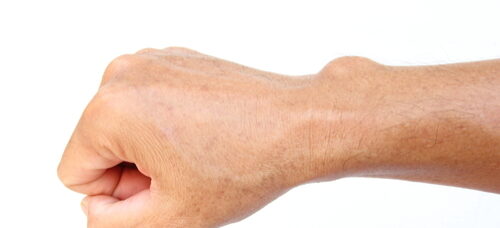
Orthoses for the Treatment of Volar Plate Injuries
Figure -of-8 orthosis versus the finger based dorsal extension blocking orthosis

Here is a review of a recent study in the Journal of Hand Therapy looking at the Figure -of-8 orthosis versus the finger based dorsal extension blocking orthosis for treatment of volar plate injuries! Following the review are instructions of how to fabricate each of these orthoses plus a hinged orthosis that can also be effective for treatment of volar plate injuries.
The volar plate
The volar plate is a thick fibro– cartilaginous ligament that connects the proximal and middle phalanges of the finger, underneath the proximal interphalangeal (PIP) joint. It’s a multilayered tissue and helps stabilize the PIP joint by preventing the joint from hyperextending backwards.

Image of Volar Plate from our textbook ‘Orthotic Design and Fabrication for the Upper Extremity: A Practical Guide’
Common injuries
Hyperextension injuries of the PIP joint are common, especially in sports. The injuries typically cause a partial disruption of the ligament with or without a fracture, but complications such as stiffness, swelling, joint deformity, pain and lack of motion are the typical result unless treated early. Conservative care is provided with a dorsal extension blocking orthosis to prevent extension and allow the volar plate to heal. Hand therapy treatments may include interventions to reduce pain and edema, and exercises to improve range of motion and increase function.
Solutions
The dorsal extension blocking orthosis
The dorsal extension blocking orthosis sits over the dorsal aspect of the finger from the fingertip to the metacarpal-phalangeal joint and holds the PIP joint in 20-30 degrees of flexion. The proximal strap holding the orthosis on the finger can be removed to allow for active motion into flexion. The degree of flexion can be gradually decreased as healing occurs.
Figure -of -8 orthosis
A Figure -of -8 orthosis is also an orthosis that limits hyperextension and is typically used in cases of PIP joint laxity. A retrospective study by Joyce et al (2014) looked at the use of the Figure -of -8 orthosis with PIP joint injuries and found positive outcomes in terms of fewer treatments and better range of motion.
Study
This current study Grange et al (2024) in the Journal of Hand Therapy compared the use of the Figure -of -8 orthoses with dorsal blocking orthoses in the care of volar plated injuries of the PIP joint. Outcome measures include range of motion, pain, function and number of therapy visits.
Method
This study was a parallel-group pilot randomized controlled trial that looked at two treatment methods. While the researchers sought a recruitment of 72 participants for a sample size that could detect a group difference of 15 degrees of PIP flexion, final recruitment involved 42 participants.
Participants were randomized into the two treatment groups and were blinded to the study outcomes. However, therapists were not blinded and conducted both the treatments and the assessments.
All participants received a custom thermoplastic finger orthosis, home exercises and education about their injury. The experimental group received a Figure -of -8 orthosis with the PIP joint in 30 degrees of flexion. This was adjusted to 15-20 degrees of flexion although it is not clear when this occurred. The control group received a dorsal extension blocking orthosis with the same positioning and had the orthosis adjusted by 10 degrees of PIP joint extension each week.
Results
Outcome measures were assessed at weeks 4, 7 and 12.
Range of motion was measured with finger goniometers. The Visual Analog Scale (VAS) was used to record pain levels. The Quick Disabilities of the Arm Shoulder and Hand (Quick DASH) was used to measure function.
Results of the study indicated that both types of orthoses can be utilized in the treatment of volar plate injuries and result in improved range of motion, decreased pain and good function. The researchers found that participants who received a dorsal extension blocking orthosis needed two additional treatment sessions which can be more costly. There were differences in the resultant PIP extension outcome trajectory possibly due to differences in baseline measures between the two groups.
Other conservative treatments have included buddy tapes, dorsal blocking orthoses, immobilization and/ or early active mobilization. This study highlights the use of the Figure -of -8 orthosis and points out that this orthosis did not require adjustments to change the degree of PIP extension. This could be significant at reducing the number of treatment sessions needed.
How to / Do it yourself
The Dorsal Finger Extension Blocking Orthosis
Materials: Orfit Colors NS 2.0 mm (1/12”)
Preparation: Cut a rectangle roughly the length of the finger and a bit wider and activate in hot water 65°C (160-165°F)
Fabrication: Mold over the dorsal finger with the PIP joint flexed to 30°. Let harden in this position. Trim corners and apply two straps. Use the heat gun to help adhere the straps, one over the proximal phalanx and the other over the DIP joint. The distal strap is removed to allow for active flexion exercises.

The Figure -of- 8 Orthosis (also called the Anti-Swan Neck Orthosis)
Materials: 1 strip of 3 cm (1/8 “) wide Orficast about 20 cm (8”) long
Fabrication: Roll the Orficast into a tight tube. Mold an oval shape over the dorsum of the first phalanx and the middle phalanx, keeping the finger in PIP joint flexion. Begin at the PIP joint on one side and complete the oval in the same spot, attaching the material to itself snugly.
Slip the remaining material under the flexed PIP joint and attach it to the opposite side of the oval. Trim the remaining material away and hold in PIP joint flexion until hardened.

Extra option: The Orficast Hinged PIP Extension Block Orthosis
Materials: Orficast 2.5” / 6 cm and Orficast 1” /3 cm Use a strip of Orficast 2.5”/ 6 cm wide and 10 to 12 cm long and a second strip of Orficast 1”/ 3 cm wide. Cut the 3 cm piece in two lengthwise.
Preparation: Heat the 2.5” / 6 cm Orficast and fold it in half lengthwise.
Fabrication:
- Pass the material under the palmar side of the proximal and middle phalanges and pinch it together on the dorsal side. Immediately cut the material with curved scissors as close to the skin as possible To avoid cutting the patient’s skin, pull the material up and away from the patient while cutting. Flex the PIP joint of the finger in 30 degrees flexion during hardening time.
- Verify the correct position of the PIP joint with a goniometer. Remove the orthosis from the patient and trim the volar distal and proximal portions of the orthosis.
- Trim an opening on the palmar surface of the orthosis to free the flexion crease of the PIP joint. Cut a small V-shaped piece at both lateral edges of the opening of the PIP flexion crease.
- To make the first of a pair of hinges, take the smaller piece of Orficast. After heating, roll the Orficast on itself, while a exerting a firm pressure on the complete length of the Orficast.
- Measure the length of the hinge and cut off the excess length. Heat both sides of the multi-centric hinge. Heat the side of the orthosis where you will stick the hinge. Stick both together.
- Repeat the same for the other side. Finally, cut the finger base of the orthosis in two by cutting from the tip of one lateral V over the dorsal side to the tip of the other V, thus enabling flexion.
- Try the orthosis on the patient and check the fit.

References
Grange, M., Carra, K., Barrett, S., & McKinstry, C. (2024). Management of stable proximal interphalangeal joint volar plate injuries with figure-of-8 orthoses: A parallel-group randomized controlled trial. Journal of Hand Therapy.
Joyce, K. M., Joyce, C. W., Conroy, F., Chan, J., Buckley, E., & Carroll, S. M. (2014). Proximal interphalangeal joint dislocations and treatment: an evolutionary process. Archives of plastic surgery, 41(04), 394-397.
![]()

Writer: Debby Schwartz, OTD, OTR/L, CHT
Physical Rehabilitation Product and Educational Specialist at Orfit Industries America.
Debby is a certified hand therapist with over 36 years of clinical experience. She completed her Doctorate of Occupational Therapy at Rocky Mountain University of Health Professions in 2010. She has worked at Orfit Industries America as Product and Educational Specialist since 2007.
Debby is also an adjunct professor at the Occupational Therapy Department of Touro University, School of Health Sciences, and at the Occupational Therapy Department at Yeshiva University, Katz School of Science and Health in NYC. She has written many book chapters in the field of hand therapy and multiple articles for hand therapy journals, including the ASHT Times and the Journal of Hand Therapy. She has published a new textbook on orthotic fabrication together with Dr. Katherine Schofield, entitled “Orthotic Design and Fabrication for the Upper Extremity: A Practical Guide”.
![]()
If you’d like to receive the latest product updates and interesting Orfit news, subscribe to our newsletter:



